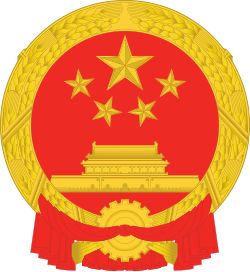Central People's Government of the People's Republic of China (1949–1954)
The Central People's Government was the central government of the People's Republic of China between 1 October 1949 and 20 September 1954. The government was formed in accordance with the Common Program and the Government Organic Law promulgated by the 1st National Committee of the Chinese People's Political Consultative Conference (CPPCC).[1] The Central People's Government served as the provisional government for exercising state power before the 1st National People's Congress (NPC) was elected to draft the new constitution of China. The government ceased to exist after the enactment of the Constitution of the People's Republic of China on 20 September 1954, and was reformed into the constitutional government of China. Since 1954, the "Central People's Government" has been synonymous with the "State Council" in the current government of China.[citation needed] HistoryOn 27 September 1949, the first plenary session of the Chinese People's Political Consultative Conference (CPPCC) passed the Organic Law of the Central People's Government. It also elected the Central People's Government Committee on 30 September 1949.[2][3] The government was then promulgated by Mao Zedong at the ceremony of Proclamation of the People's Republic of China on 1 October 1949. On 20 September 1954, with the enactment of the Constitution of the People's Republic of China by the 1st National People's Congress (NPC). The Central People's Government ceased to exist and was reformed into the new constitutional government of China. Organizational structureThe Central People's Government was then composed of:[3]
Between 1953 and 1954, there were 6 regional administrative councils:
In September 1954, with the enactment of the new constitution of China:
See also
References
External links
|
|||||||||||||||||||||||||||||||||||||||||||||||||||||||||||||||||||||||||||||
Portal di Ensiklopedia Dunia















